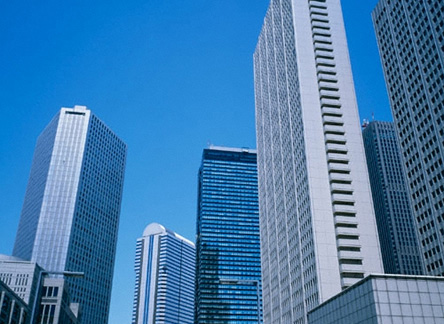- KDDI HOME
 Corporate Information
Corporate Information  Investor Relations
Investor Relations  IR Documents
IR Documents  IR Meetings
IR Meetings  IR Meetings: FY2020.3
IR Meetings: FY2020.3
IR Meetings
SDGs Presentation Meeting (October, 10, 2019)
| Date/Time | October, 10, 2019 (Thur.) 2:30 p.m. to 4:30 p.m. |
|---|---|
| Location | Conference Room, Garden Air Tower (Chiyoda-ku, Tokyo) |
| Description of presentation | KDDI's target SDGs established in the medium-term management plan and KDDI's vision based on the sustainability policy, focusing on communications, regional revitalization, and corporate govenrnance are mainly explained. |
| Participants | Approx. 50 investors, analysts and press members |
| Panelists | Shinichi Muramoto, Senior Managing Executive Officer Minoru Tanaka, General Manager, General Administration Division Kazuyuki Yoshimura, General Manager, Operations Division Shigeki Matsuno, Deputy General Manager, Corporate Strategy Planning Division Keita Horii, General Manager, Investor Relations Department (MC) |
Materials
Part 1: Explanation of "KDDI's Target SDGs"
Senior Managing Executive Officer Muramoto explained our cycle of aiming for sustainable growth and development. He introduced the social issues that we aim to solve through our business and company activities, as well as our previous efforts to solve these issues.
After that, General Manager Yoshimura of the Operations Division and General Manager Tanaka of the General Administration Division discussed our efforts to provide secure and resilient communications services, as well as our disaster countermeasures. Deputy General Manager Matsuno of the Corporate Strategy Planning Division discussed our regional revitalization efforts, and General Manager Tanaka of the General Administration Division discussed corporate governance.
Participants gained a better understanding of the contributions to sustainable growth of society that we are aiming to achieve.
Part 2: Q&A Session
In the Q&A session, Senior Managing Executive Officer Muramoto and the panelists provided answers to questions from the participants.
Questioner 1
-
-
 The sustainability targets are outlined on page 8, but could you explain the reasoning and processes for deciding the target values, particularly for the "Global" target of six ICT projects aimed at bridging the digital divide, and the "Regional revitalization" target of more than 60 efforts in revitalization to solve regional issues using IoT and ICT?
The sustainability targets are outlined on page 8, but could you explain the reasoning and processes for deciding the target values, particularly for the "Global" target of six ICT projects aimed at bridging the digital divide, and the "Regional revitalization" target of more than 60 efforts in revitalization to solve regional issues using IoT and ICT? 
 First, regarding the "Global" target of six ICT projects aimed at bridging the digital divide, we held discussions with each business division, and we identified and quantified the efforts by KDDI Foundation that can contribute to the SDGs for the next three years.
First, regarding the "Global" target of six ICT projects aimed at bridging the digital divide, we held discussions with each business division, and we identified and quantified the efforts by KDDI Foundation that can contribute to the SDGs for the next three years.
As for the "Regional revitalization" target of more than 60 efforts in revitalization to solve regional issues using IoT and ICT, we set a three-year target. The reason is that even in trial testing, for example, the process involves consulting with partners and achieving results through a great deal of trial and error, so it inevitably takes some time. Among the agreements that have been made, we looked at each one individually and considered how many can be achieved in three years. As a result, we set the target at 60.
-
-
-
 What is the current state of progress in the reduction of CO2 emissions, and what are KDDI's unique efforts in this area?
What is the current state of progress in the reduction of CO2 emissions, and what are KDDI's unique efforts in this area? 

The CO2 emissions reduction target has been set as a medium-to-long term target to be achieved by FY2030.
We believe that the achievement of the target will be affected by various market conditions, as well as factors such as the amount of renewable energy supplied in Japan, or other changes in society.
As for the current situation, CO2 emissions increased slightly above target in FY2018.
The details are also provided in the Sustainability Report that was published in September 2019, so you are encouraged to refer to it for more.KDDI's unique efforts are to make use of energy-efficient equipment and renewable energy.
As a characteristic of the telecommunications business, the amounts of CO2 emissions and power consumption are both on the rise, so we have ventured to set quantitative targets to reduce these amounts.
On these points, we believe that our efforts put us a step ahead of the competition.
-
-
-
 CO2 emissions will inevitably increase with the widespread adoption of 5G. Is it possible to control the emission amounts through the efforts of the equipment vendors?
CO2 emissions will inevitably increase with the widespread adoption of 5G. Is it possible to control the emission amounts through the efforts of the equipment vendors? 

Regarding the improved energy efficiency of the equipment itself, it is dependent on the technology development of the vendors.
KDDI is also engaged in the data center business, which consumes a great deal of power.
Regarding the power consumption of the data center business, we have set the indicators of efficiency improvements as KPIs and shared the information with vendors. We are aiming for rather high targets.
To improve the efficiency of operations in data centers, we are considering the installation of equipment such as systems for monitoring the air conditioning in our new buildings in the future.In addition, a large number of base stations are being constructed for 5G, which will lead to an increase in power consumption.
Through activities such as our base station sharing agreement with SoftBank, we can construct the base stations more efficiently and curtail the overall power consumption.
Since power consumption is a major issue, we will continue our efforts moving forward.
-
Questioner 2
-
-
 Could you explain the positioning of the social issues described on pages 8 and 9?
Could you explain the positioning of the social issues described on pages 8 and 9?
For example, are there any links between target achievement and factors such as the remuneration of executives?
 The SDG targets themselves are not linked directly to the remuneration of executives. However, SDG targets are set based on the assumption that they are linked to medium-term business plans, so our SDG targets are linked to the KPIs of the medium-term management plan.
The SDG targets themselves are not linked directly to the remuneration of executives. However, SDG targets are set based on the assumption that they are linked to medium-term business plans, so our SDG targets are linked to the KPIs of the medium-term management plan.
Since the remuneration is linked to the KPIs of the medium-term business plan, it is therefore indirectly linked to the SDG targets.
-
-
-
 About governance, the diversity and expertise of outside directors are described on page 92. However, if we look at it from a different perspective, the representatives of the largest shareholders are among the outside directors. Regarding this situation in which directors are mutually dispatched between KDDI and the largest shareholders, could you explain the reasons for why those directors are required?
About governance, the diversity and expertise of outside directors are described on page 92. However, if we look at it from a different perspective, the representatives of the largest shareholders are among the outside directors. Regarding this situation in which directors are mutually dispatched between KDDI and the largest shareholders, could you explain the reasons for why those directors are required? 
 First of all, KDDI does not dispatch directors to other companies, so it is not accurate to describe this as a mutual dispatch of directors.
First of all, KDDI does not dispatch directors to other companies, so it is not accurate to describe this as a mutual dispatch of directors.
We receive a variety of suggestions, and we select the members while taking into consideration the diversity and expertise of the directors as a whole. We clearly explain our stance at the General Shareholders Meeting each year.
-
Questioner 3
-
-
 Can you provide specific examples of issues related to disaster recovery?
Can you provide specific examples of issues related to disaster recovery? 
 We had an optimistic outlook for the recovery of the network after Typhoon No. 15, but the damage turned out to be worse than anticipated.
We had an optimistic outlook for the recovery of the network after Typhoon No. 15, but the damage turned out to be worse than anticipated.
The important thing is to immediately begin disaster response activities when the risk is detected. That way, if the damage later turns out to be less than anticipated, it is all right to stop the activities. However, if we underestimate the problem and fail to start implementing the disaster response, the damage will be great.
Since disasters occur unpredictably and are different each time, it is difficult to anticipate them and respond in advance.
-
-
-
 On page 25, there is an explanation about expediting the disaster response investments. Did these expedited investments benefit the recent disaster responses?
On page 25, there is an explanation about expediting the disaster response investments. Did these expedited investments benefit the recent disaster responses? 
 Due to the expedited investments, we were able to reduce the recovery time. The equipment that we invested in this time is distributed across Japan, but we were able to transport it to the disaster areas for the response, so it played a rather significant role.
Due to the expedited investments, we were able to reduce the recovery time. The equipment that we invested in this time is distributed across Japan, but we were able to transport it to the disaster areas for the response, so it played a rather significant role.
Although the damage from the recent Typhoon No. 15 was concentrated in Chiba, we will perform simulations to ensure a quick response even in situations where the damage is spread across Tokyo and the neighboring three prefectures, and we will increase the investments accordingly.
-
-
-
 How significant a role does each individual regional revitalization project play in the ongoing regional revitalization efforts, from the perspective of sustainability?
How significant a role does each individual regional revitalization project play in the ongoing regional revitalization efforts, from the perspective of sustainability? 
 Other companies are also pursuing regional revitalization efforts from the perspective of SDGs. However, there are not yet any successful case examples that are visible.
Other companies are also pursuing regional revitalization efforts from the perspective of SDGs. However, there are not yet any successful case examples that are visible.
We are considering how to utilize our telecommunications technologies such as IT and ICT to solve the regional issues of the shrinking labor force due to the declining population and the aging of society. One example is our measure for reducing the damage caused by wild boars.
However, if such measures end up becoming expensive services, they will ultimately increase the economic burden on the regions that use them.
Also, to ensure that the people in the regions use the measures, it is necessary to increase the technological literacy of the people in the region, and provide a solid system of support.
KDDI has many cases where trial tests have demonstrated the ability of technology to solve issues. However, in order to provide actual services, it is necessary to develop tools that the people in the regions will use.
Since these types of efforts are not able to quickly produce results within a short period, we believe they should be pursued gradually over the long term.
-
-
-
 I believe different regions are facing the same issues. Are you conducting efforts such as connecting individual projects and scaling them horizontally or creating networks?
I believe different regions are facing the same issues. Are you conducting efforts such as connecting individual projects and scaling them horizontally or creating networks? 
 While local governments are conducting their own trial tests, we believe it is necessary to take the successful case examples and scale them horizontally.
While local governments are conducting their own trial tests, we believe it is necessary to take the successful case examples and scale them horizontally.
KDDI has a network with venture companies, so we believe that developing a platform will be an issue moving forward.
-
Questioner 4
-
-
 What was the scale of the increase in investments for disaster response?
What was the scale of the increase in investments for disaster response?
Also, what scale of disaster is being envisaged when considering the increase in future investments?

 The scale of the investment amount is not disclosed. As for the envisaged disasters, we are making preparations for an earthquake directly under the Tokyo metropolitan area and three neighboring prefectures, and an earthquake in the Nankai Trough. This does not necessarily mean that the investments are sufficient, so we are planning to further enhance the capabilities of equipment such as mobile base stations as needed in the future. However, even if we do not greatly enhance the capabilities as we did this time, we believe that the countermeasures have been prepared to a considerable extent.
The scale of the investment amount is not disclosed. As for the envisaged disasters, we are making preparations for an earthquake directly under the Tokyo metropolitan area and three neighboring prefectures, and an earthquake in the Nankai Trough. This does not necessarily mean that the investments are sufficient, so we are planning to further enhance the capabilities of equipment such as mobile base stations as needed in the future. However, even if we do not greatly enhance the capabilities as we did this time, we believe that the countermeasures have been prepared to a considerable extent.
Also, the disaster countermeasures do not consist only of hardware side. They also consist of operations, for which it is important to improve the efficiency.
For example, in the response to Typhoon No. 15, we were slow to deploy the equipment to southern Chiba prefecture, so some of it ended up going unused.
Moving forward, we will also take the operations into account when considering the disaster countermeasures.
-
-
-
 In this SDGs Presentation Meeting, I have gained a better understanding of the management and company efforts. However, could you explain how you are improving employee awareness about the SDGs, and how you are improving motivation?
In this SDGs Presentation Meeting, I have gained a better understanding of the management and company efforts. However, could you explain how you are improving employee awareness about the SDGs, and how you are improving motivation? 

The current medium-term management plan was announced publicly, and we are proceeding to communicate it within the company.
The employee awareness surveys indicate that there is an understanding of the big picture and the direction that we are aiming for. However, we have heard opinions from employees suggesting that the connections to their own work and positions have not been clearly established, so that they do not know specifically what actions should be taken.
As a result, since last year, the board members, including the President, have separately been holding interactive meetings at each level in each department across Japan, to foster a full understanding of the medium-term management plan and SDGs.
Through such efforts, we believe that the results will gradually become apparent.We believe it is necessary to take both top-down and bottom-up approaches across the entire company.
For example, the top-down approach includes study sessions for executives, including the directors, while the bottom-up approach includes company-wide education through e-learning.
In addition, since the SDG contributions are made through the business operations, each business division has started conducting educational activities.
Our aim is for all employees to engage in these efforts, so we would like to create an environment in which all employees can pursue these efforts in accordance with the medium-term management plan for the next three years.
-
Look of the presentation meeting


Shinjuku Building Telecom Facilities Tour (February 19, 2019)
| Date/Time | February 19, 2019 (Tue.) 2:30 p.m. to 4:40 p.m. |
|---|---|
| Location | KDDI Shinjuku Building (Shinjuku-ku, Tokyo) |
| Description of tour | Visitors will receive a guided tour of the centers that operate and/or monitor KDDI's telecom networks and optical fiber facilities as well as a question-and-answer session. |
| Participants | 25 investors and analysts |
| Panelists | Uchida, Executive Director, Technology Sector; Executive Vice President, Representative Director Okuyama, General Manager, Operations Division, Technology Sector; Administrative Officer Furuhata, Director, Mobile Operation Center, Operations Division Harada, Vice Director, Global Network Operation Center, Global Engineering & Operations Division Kawakami, Manager of Network Communication Section, Network Technical Development Division Horii, General Manager, Investor Relations Department (MC) |
Part 1 Briefing on KDDI's efforts
Operations Division GM Okuyama briefed on KDDI's infrastructure and operations/maintenance frameworks in Japan and abroad. He explained the redundancy in facilities, double-tracking mechanisms, and staffing, and other factors of the operations system that maintains the communication infrastructure that shapes the foundation of our business 24 hours a day, 7 days a week. Specific efforts in the wake of previous disasters were introduced along with details of disaster recovery training in preparation for large-scale disasters. The participants learned about KDDI's efforts for recovering and maintaining communication means as soon as possible as part of the lifeline in case of emergencies.
Part 2 Tour of the facilities
The participants were given a guided tour of the Mobile Operation Center, which monitors and operates au's mobile telecom services, the Global Network Operation Center, which monitors and operates overseas telecom services, and the underground cable tunnel, where the optical fiber cables are installed.
Part 3 Question-and-answer session
In the question-and-answer session, Vice President Uchida, concomitantly Executive Director of the Technology Sector, and other panelists answered the participants' questions.
Questioner 1
-
-
 I reckon that more base stations will be established for 5G. I would like to know about the operating framework and costs. Also, how do you see the virtualization technology that Rakuten is planning to implement?
I reckon that more base stations will be established for 5G. I would like to know about the operating framework and costs. Also, how do you see the virtualization technology that Rakuten is planning to implement? 
 In preparation for the full release of 5G, we are promoting the standardization of currently segmented operations as well as the optimization of processes, which is one part of our automation efforts. The increase in the number of base stations will not lead to a simple proportional increase in operating costs.
In preparation for the full release of 5G, we are promoting the standardization of currently segmented operations as well as the optimization of processes, which is one part of our automation efforts. The increase in the number of base stations will not lead to a simple proportional increase in operating costs.
We believe that the virtualization technology is in line with the modern trend, but will have a number of issues in the attempt to provide a comfortable communications environment. KDDI currently has more than 40 million customers using our services, and we are working meticulously to be able to respond to failures and sudden surges in traffic.
-
Questioner 2
-
-
 The international center for operation and maintenance (GNOC) is based in Vietnam. What is the reason for having a center in Vietnam?
The international center for operation and maintenance (GNOC) is based in Vietnam. What is the reason for having a center in Vietnam? 
 We have many personal and corporate customers in Southeast Asia, which is why we wanted to establish an operation and maintenance base in this area. With all things considered around the establishment of a base in Southeast Asia, we decided on Vietnam.
We have many personal and corporate customers in Southeast Asia, which is why we wanted to establish an operation and maintenance base in this area. With all things considered around the establishment of a base in Southeast Asia, we decided on Vietnam.
-
Questioner 3
-
-
 What is the difference in the operation framework between the IoT global platform and the current network?
What is the difference in the operation framework between the IoT global platform and the current network? 
 The IoT global platform will be an intricate combination of networks around the world. A dedicated operation framework is established in Shinjuku, Tokyo, to promote coordination with overseas partners according the situation in each region.
The IoT global platform will be an intricate combination of networks around the world. A dedicated operation framework is established in Shinjuku, Tokyo, to promote coordination with overseas partners according the situation in each region.
-
Questioner 4
-
-
 I would like to know the scale of the staff operating and maintaining the KDDI network. Additionally, please elaborate on the current competitive environment for the submarine cable business.
I would like to know the scale of the staff operating and maintaining the KDDI network. Additionally, please elaborate on the current competitive environment for the submarine cable business. 
 While we cannot disclose the specific number, we can say that the staff is made up of a combination of contractors, business partners, and regular KDDI employees and that staffing is revised according to the workload.
While we cannot disclose the specific number, we can say that the staff is made up of a combination of contractors, business partners, and regular KDDI employees and that staffing is revised according to the workload.
Enterprises from different industries entered the submarine cable business for investment purposes, anticipating an explosive increase in demand for traffic. However, nowadays, with improved methods of ensuring sufficient communication capacity, even with some OTT businesses entering the market to ensure sufficient capacity for traffic, the competitive environment remains stable.
-
- Other IR Information
Investor Relations
E-mail Alerts
- KDDI IR Official Twitter
- Recommended Contents
-









<Comments from the participants>
The event gave me a clear understanding of the network operations worldwide.
It renewed my knowledge of KDDI's numerous initiatives to maintain infrastructure as a comprehensive telecommunications carrier.
I learned that the wide-zone base station provides sufficient coverage for the Tokyo area in emergencies.
<Participants' Rating>